Training at HMI Darjeeling – (Himalayan Mountaineering Institute in India)
A detailed breakdown of my experience on the Basic Mountaineering Course (BMC) at HMI Darjeeling, the most renowned Himalayan Mountaineering…
A detailed breakdown of my experience on the Basic Mountaineering Course (BMC) at HMI Darjeeling, the most renowned Himalayan Mountaineering Institute in India.
After years of hiking and trekking around the world, I was longing for the opportunity to embark on some more technical mountaineering ascents. However, growing up in Australia, a mostly flat nation with only one notable peak, didn’t offer many opportunities to hone my technical mountain skills.
So, I began researching the best ways to acquire those skills and quickly found that a Basic Mountaineering Course (BMC) would be the best place to start. I’d done some trekking in the Himalayas before, including Nepal’s famous Three Passes Trek, so I knew that basic mountaineering adventure courses in the Himalayas would be right up my alley.
| Type Of Sandwich | How much I love it | Would I eat it again |
| Peanut Butter and Jelly | 10/10 | Any day of the week |
| Ham and Cheese | 7/10 | Maybe if there’s no other choices and now my text is pretty long so there’s a chance we’re going to wrap under |
| BLT | 1000/10 | I dream about BLT |
After a recommendation from a friend, I ended up enrolling in the BMC at the Himalayan Mountaineering Institute (HMI) in Darjeeling, West Bengal – a school with an international reputation and as one of India’s premier mountaineering institutes.
This article is aimed at informing those interested in enrolling at HMI, or those curious about Himalayan mountaineering schools in India. I’ve included tonnes of information about the BMC course and the institute, as well as a detailed day-by-day breakdown of my experience with an honest review of the course at the bottom of this post.
- About HMI Darjeeling (Himalayan Mountaineering Institute)
- Getting to Darjeeling
- What to Expect From a Mountaineering Course at HMI Darjeeling
- My Experience of the Basic Mountaineering Course at HMI
- Day 0: Initiation and Checking into the HMI Hostel
- Day 1: Getting Settled into HMI Campus
- Day 2: Climbing Ropes & Knots
- Day 3: First Day at Tenzing Rock
- Day 4: More Rock Craft & HMI Lectures
- Day 5: First “Hike” and Rappelling at Tenzing Rock
- Day 6: Day at Tenzing Rock
- Day 7: Tenzing Rock and Indoor Climbing
- Day 8: Jumar Practice & Stretcher Training
- Day 9: Pandem Trekking Test (fitness Test)
- Day 10: Preparing for Sikkim
- Day 11: Journey to Yuksom
- Day 12: Trek from Yuksom to Tshoka
- Day 13: Acclimatization in Tshoka
- Day 14: Tshoka to Dzongri
- Day 15: Dzongri to HMI Base Camp
- Day 16: First Day at HMI Base Camp
- Day 17: First Glacier Training Day
- Day 18: Ice Climbing on Rathong Glacier
- Day 19: Aid Climbing and River Crossing Practice
- Day 20: Bad Weather in Sikkim
- Day 21: Jumar Ascent on Rathong Glacier
- Day 22: Final Glacier Training Day
- Day 23: Height Gain on Renok Peak
- Day 24: The Sikkim Descent: HMI Base Camp to Tshoka
- Day 25: Tshoka to Himalayan Mountaineering Institute
- Day 26: HMI Sports Climbing Competition
- Day 27: Graduation
- Fun Things to do in Darjeeling After the Basic Mountaineering Course
- Preparing For the BMC at the Darjeeling Himalayan Mountaineering Institute
- Final Review: Would I recommend HMI to Aspiring Mountaineers?
- More Photos from the BMC With HMI Darjeeling
- More Adventure Inspiration After The Mountaineering Course



About HMI Darjeeling (Himalayan Mountaineering Institute)
HMI Darjeeling is one of the oldest and longest-running mountaineering institutes in the world. It was founded by Pandit Jawaharlal Nehru (India’s first Prime Minister) and Tenzing Norgay in 1954, just one year after Sir Edmund Hillary and Norgay made the first successful ascent of Mount Everest (8848 m).
HMI’s most popular course is the BMC, which attracts a long waiting list for Indians (more on this later), but they also offer the Advanced Mountaineering Course, Search and Rescue, Method of Instruction Course, and various special courses like the adventure courses (trekking and summits).
The institute is strangely located within the Darjeeling Zoological Park, meaning trainees and visitors must walk through the zoo to get to the institute’s entrance gates. You’ll find the entrance to this zoo on Lebong Cart Rd, a short walk from Chowrasta and Chauk Bazar, Darjeeling.
HMI is a government-run facility (jointly by the government of India and the Government of West Bengal). It’s headed by the Defence Minister and the Chief Minister of West Bengal. As a result, the organization is much more militaristic, hierarchal, and bureaucratic than western climbing schools.

Tenzing Norgay: HMI Darjeeling is well-known in India and the global mountaineering world for being founded by Sherpa Tenzing Norgay (along with Sir Edmund Hillary, the first man to summit Everest). Norgay served as the institute’s first Director of Field Training and largely shaped the early course structures. Today, there is a memorial outside the HMI museum dedicated to Norgay.
Getting to Darjeeling
The easiest way to get to Darjeeling is to fly to the nearby domestic airport of Bagdogra. There are several flight routes connecting to Bagdogra via large Indian transit hubs like Delhi and Kolkata. Domestic flights in India, including routes to Bagdogra, are quite affordable, especially if you compare prices across airlines using tools like

From Bagdogra airport, it is very easy to arrange a taxi to Darjeeling on arrival. Simply walk past the baggage collection area and immediately before reaching the exit, turn left down the narrow hallway to a small taxi office. The official price for a taxi to Darjeeling is 1500 INR (approximately $18 USD), which is very fair for the long and very winding 3-4 hour drive.
Just be prepared, Darjeeling’s second name is the Queen of Hills, and this is no exaggeration.
Transport Tip: Travelers can also

Alternative Transport Options to Darjeeling
Alternatively, travelers can opt for slightly cheaper but much longer overland journeys to Darjeeling from cities across India.
If you use
There’s also a train station in Siliguri, meaning you can use RedBus again to book train tickets from nearby cities including Kolkata.
Tip: In my opinion, sleeper buses in India are much more comfortable and more convenient than trains.

About the Basic Mountaineering Course
The Basic Mountaineering Course (BMC) in India is a 28-day course designed to take beginner mountaineers (men & women) and provide them with all of the skills necessary to embark on expeditions up to 7,000 meters.
The course is split into theoretical (classroom lectures) and practical components covering topics such as the use of mountaineering equipment and technical clothing, rock craft, ice craft (glacier training), snow craft, etc.

The BMC is split up with an initial 8 days spent at the Himalayan Institute in Darjeeling, followed by a 4-day trek from Yoksum to HMI Base Camp at Chaurikhang, West Sikkim (4500 m). Then, trainees spend 10 days at the camp for field training and height gain, followed by a 2-day descent trek and 2-3 days of written tests, formalities, and graduation once back at HMI.
All mountaineering institutes in India offer a standardized course program for the BMC. This means that candidates looking to progress to the Advance course can do so at other schools as well. However, only candidates with a graduating score of A or above are permitted to progress to further mountaineering training in India.
Course schedules run during March, April, May, September, October, and November.

Indian climbing regulations: The BMC is a very popular course in India with a long waiting list. The reason is that its completion is a preliminary requirement for Indian citizens wanting to embark on an above 7,000-meter expedition in the Indian Himalayas. Strangely, the Indian government does not have any formal training restrictions for foreign nationals on any expedition. However, it may help if mountaineers apply for climbing permits themselves with the intent to climb alpine style.
Enrollment Process
The enrollment process for the BMC at the Himalayan Mountaineering Institute varies greatly depending on whether you are a foreigner or an Indian national.
Unfortunately, I can’t comment much on the Indian process. However, after speaking to people on my course, they’ve told me that in order for Indians to apply, they must put their names down and wait for up to two years. There are also Indian military slots and sponsorship slots from programs like the cadets. If you’re an Indian reader, I recommend contacting HMI directly.
For non-Indians, there are foreigner slots available. These are separate from the regular waiting list slots for Indians and allow people from other nations to enroll as late as a few months in advance. However, foreigners (and Indians who want to pay full price for the early enrollment) have to pay the full course fees, which in 2022 was roughly $1000 USD (but seems as if is increasing yearly). Waiting list candidates pay a fraction of this.
Both Indians and foreigners will need to complete the enrollment form, as well as a very lengthy and thorough medical assessment form. The medical requires everything from an ECG to chest X-rays, which was frustrating for me as somebody who lives on the road.
In order to complete your enrollment, you’ll also need to forward 10% of the course fees as a deposit after emailing a copy of your Application Form and Medical Form to the HMI staff.
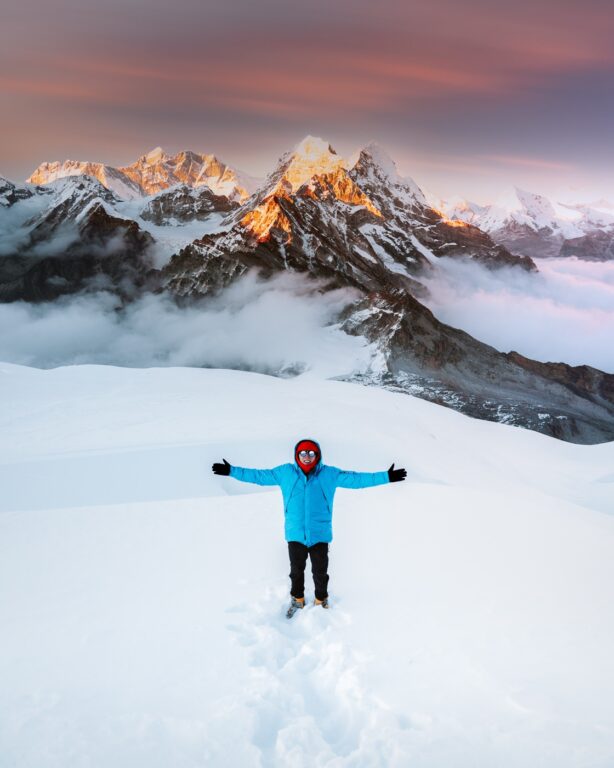
Insurance for the BMC at HMI
Mountaineering insurance up to 5000 m+ is compulsory for all candidates at HMI Darjeeling. Since most travel insurance companies void coverage as soon as you step above 4500 m, I strongly recommend
What to Expect From a Mountaineering Course at HMI Darjeeling
Before I dive into my day-by-day recap, here’s a bit of information about the facilities at HMI Darjeeling.
The Institute (Campus)
The first thing you’ll notice about the HIM campus is that it is quite big, with several wings and facilities. Below I’ve included a small list of these facilities, as well as some photos beneath.
- Javal Hall (auditorium) – a large lecture theatre hall capable of accommodating more than 225 students at a time. Used for lectures and training presentations.
- PTI Hall – a regular classroom with folding-table desks where HMI instructors deliver smaller lectures and classes.
- Library – a well-stocked library containing loads of mountaineering and travel books.
- Gym – small strength and fitness gym with a few weight machines and treadmills. Unfortunately, this was closed during my course.
- Indoor Rock Climbing Hall – basic indoor sports climbing wall.
- Outdoor Rock Climbing Wall – impressive 50′ x 20′ sport climbing wall with traditional lead, top rope, and speed climbing sections.






Lodging (Hostel)
True to Indian customs, the HMI campus hostel is split up into two wings– one for males and one for females. This means that couple enrollees will be separated.
The hostels are 3 stories high, with several rooms on each floor accommodating up to eight students in bunkbed-style dorms. There are also large metal lockers for each student in the room.
On each hostel floor is a bathroom with mostly Asian (squatter) toilets and a couple of showers. The hot water geezers only turn on in the morning.
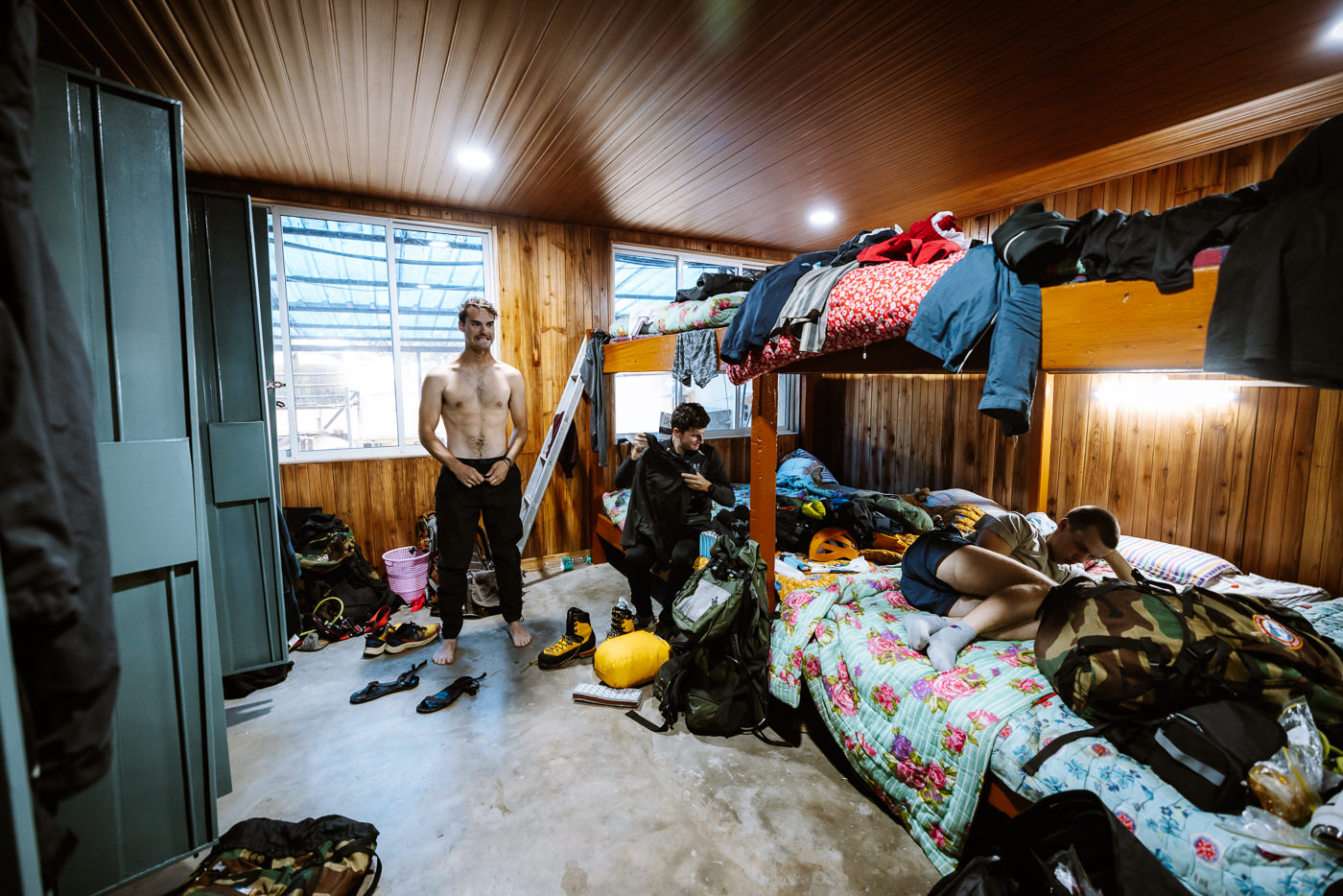

Food (Dining Hall)
Trainees receive three meals a day (breakfast, lunch, and dinner), served in a large, open dining hall.
These meals are mostly rice and dal based and are quite basic in terms of variety. Honestly, eating the same food for every meal was one of the most difficult parts for me on this course. At first, I thought it was me who needed to adjust to an Indian diet, but in the end, it seemed that the majority of the Indian candidates were also longing for variety.
The bonus here is that you are able to walk up and get as many servings as you want, assuming you finish your plate. Oh, and there are many, many “tea breaks” for chai and biscuits throughout the course, both on campus and at HMI Base Camp.


Equipment
Apart from a basic list of essential items like sports shoes for PT, trekking boots, gloves, and base layers, HMI provides all necessary mountaineering equipment and technical clothing required for the expedition to West Sikkim.
A basic list of the gear provided includes:
- Backpack (large 80L hiking backpack)
- Sleeping mat
- Sleeping bag
- Mess tin
- Down jacket
- Balaclava
- Rain jacket & pants
- Climbing harness
- Jumar, figure-8 descender, carabiners, piece rope
- Ice Axe
- Crampons
The overall quality of the equipment is good enough for the BMC. However, in terms of international mountaineering standards, the equipment is well– let’s just say I wouldn’t climb any serious peak with this gear.
Therefore, if you have your own equipment such as Gore-Tex shells or technical gear like an ice axe or crampons, I highly recommend bringing it for the course.

HMI Base Camp
The HMI Base Camp is located at Chaurikhang, West Sikkim at 4500 meters. The camp is positioned on a grassy hill just above the Rathong River and is surrounded by beautiful peaks including Rathong, the Kabru Mountains, Mount Frey, and Kokthang.
The facilities at Base Camp are quite impressive, offering a hut for accommodation (expedition tents for the Advanced course trainees), equipment rooms, toilets (squatter drop toilets), dedicated training areas, a medical office, and full kitchen.




Don’t miss: Guide to Picking Trekking Travel Insurance (no altitude caps)
HMI Museum, Darjeeling Zoo, and Treetop Rope Course
As mentioned earlier, the HMI campus sits within the Darjeeling Zoo. In fact, the institute earns some money from tourists who visit HMI to tour the grounds. While initially, this made me feel a little strange since there’d be random families asking me for selfies, I quickly got over it.
Something else I didn’t expect was that we were not allowed to leave the gates once we’d received our hostel slips, even to tour the zoo. Therefore, if it’s your kind of thing, I’d dedicate some time to check it out before or after the course.
On the other hand, the HMI Museum, which I highly recommend, is within the walls of the institute, meaning candidates can visit during downtime. This museum features some historical items including Tenzing Norgay’s Everest summit jacket and axe. This is also the oldest mountaineering museum in India.
Additionally, just outside the museum is a souvenir shop and a small cafeteria serving basic meals like momos or sandwiches, which were a great treat when we had the chance to visit.
The Treetop Course is a new addition inside the HMI Darjeeling grounds but is off-limits to candidates and really not worth the time in my opinion.
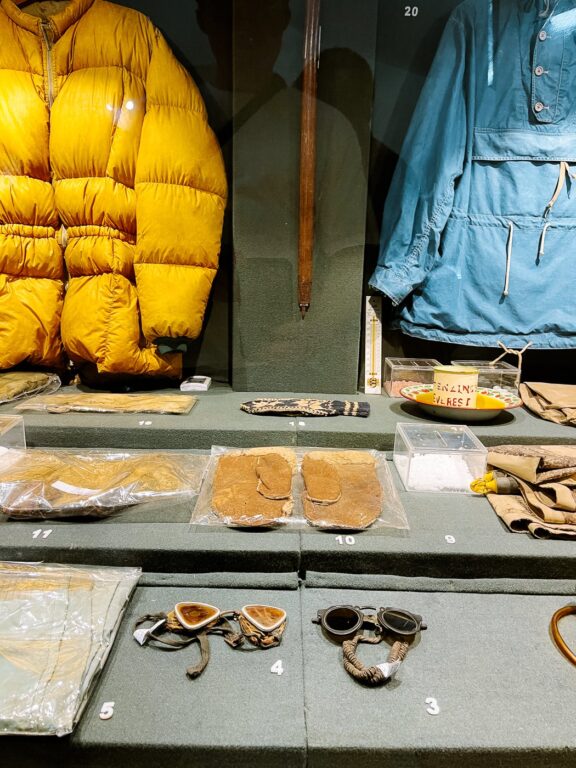
My Experience of the Basic Mountaineering Course at HMI
In this section, I’ll provide a quick day-by-day recap of my experience in the Basic Mountaineering Course to help you understand what to expect. Of course, the BMC structure will likely not be exactly the same as you’ll experience as some outdoor activities like rock climbing are weather dependent.
However, this will give you a good idea of what it’s like undertaking the course at HMI Darjeeling, especially as a foreigner.

Day 0: Initiation and Checking into the HMI Hostel
We reached HMI Darjeeling just after midday on the scheduled arrival day. Upon arrival, we were greeted by administrative staff who then guided us through the introduction process.
This was quite straightforward, with just a few forms and documents to sign, as well as a brief medical report check. We were also offered the option to purchase insurance for 1000 Indian rupees which would cover us for the entire course. Shortly after, we were handed our Hostel Slip, which we passed to the quartermaster, who then assigned us our hostel rooms.
After quickly settling in, we were given a quick introduction in the Javal Hall (large auditorium), followed by our first dinner together. This was a good opportunity to meet the other trainees and get settled in for the course.
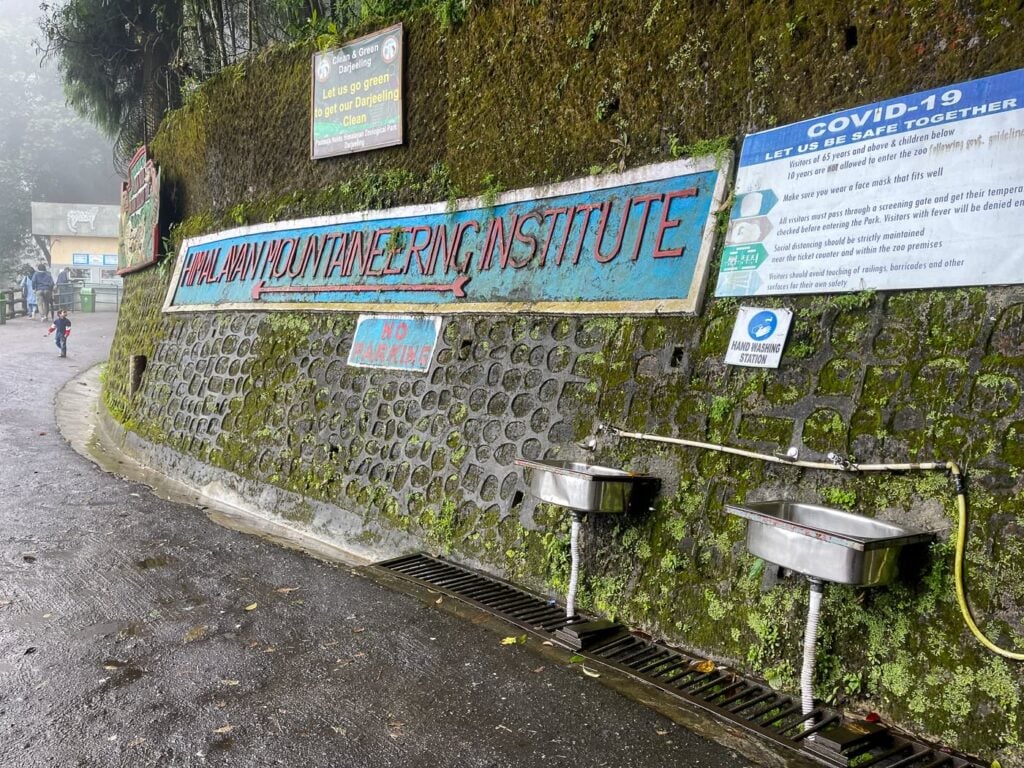
Day 1: Getting Settled into HMI Campus
The first day at HMI was all about getting prepared.
The day started at 6:50 am with the assignment of ropes, which are essentially small groups of 5-6 people that we’d stay in for the remainder of the course. Interestingly, the instructors split the 63 trainees up by region, then assigned ropes in a way that would mix people from different states of India (as well as one foreigner per rope).
First PT Session
Shortly after, we began our first PT (physical training) session. This involved a morning jog through the Darjeeling Zoo and around the soon-to-be familiar loop down Mall Road to Chowrasta that we’d run for the next week.
The first section of this easy 5-km jog involves a slight incline but I was surprised that the instructors really kept a very slow pace, to begin with (roughly 7.5-minute kilometers). Additionally, the jog was broken up with a short PT session at a nearby courtyard involving basic bodyweight exercises and stretches.
While this was not overly demanding by any means, I believe that this 1 hour PT session is structured to help trainees acclimatize to the 2000-meter altitude at the campus.
Campus Orientation
After a quick shower and Indian breakfast, we lined up (HMI calls it “Fall-In”) in the courtyard in lines of ropes. This process involved the assignment of an alternating Rope Leader, which we would take turns being every two days.
The responsibility of the Rope Leader was to ensure that all other rope members were present when called. This would be a common occurrence for the next week following each break or meal.
Shortly after, the instructors walked us around the campus and introduced us to all of the facilities including:
- Indoor Rock Climbing Hall
- Library
- PTI Lecture Hall
- Outdoor Rock Climbing Area
- HMI Museum
- Tenzing Norgay Sherpa Plarque
- Equipment Wing
- Medical Wing

First Lectures
Next up, we were treated to a decent lunch followed by our first lecture on mountain equipment.

Final on-site Medicals
I was quite surprised at just how thorough HMI was with its medical inspections. Not only were we required to undergo some pretty thorough reports before arriving, but we were also inspected on day one by the onsite medical team.
This involved a quick checkup on our vitals, including blood pressure and heart rate, as well as weight and height reporting and a quick chat with the medical officer.
Receiving Our Mountaineering Equipment
After a quick chai tea break (get used to these), we were then instructed to report to the Equipment Wing to receive our assigned equipment. This equipment included:
- Rucksack
- Waterproof Jacket and Pants
- Massive Down Jacket
- Sleeping Bag & liner
- Mess Tin
- Harness & Hardware (Jumar, carabiners, etc)
- Woolen balaclava
- Water bottle
- Rappelling jacket
If we had brought some of our own equipment, including drink bottles, harnesses, etc, we were told that we didn’t need to rent this and that we could use our own.

Evening Lecture
To wrap up the day we attended a 45-minute lecture on mountain manners and other formalities expected of us.

Day 2: Climbing Ropes & Knots
Just like on day 1, the second day started with a PT session commencing at 6:50 am. Again, we ran the same loop but this time at a gradually faster pace. I still found this to be very easy and was a little surprised at just how little physical effort was expected of us.
Following PT, we had roughly one hour to have a quick shower and eat breakfast together before fall in.
Morning Lecture: Rope
The first lecture of the day was held in the auditorium and contained useful information about rope use in mountaineering.
Practical: Learning Knots & Mountaineering Rope Use
After a quick tea break, we were asked to report to the Outdoor Climbing Area for a rope and knot learning session. I really enjoyed this session as we learned many different types of knots that we’d use every day for the rest of the course.
Some of the main knots and hitches used in the BMC at HMI Darjeeling include:
- Guideman knot
- MIddleman Knot
- Figure of eight
- Bowline (various methods)
- Bowline on the bite
- Reef knot, fisherman’s knot, sheet bend
- Clove hitch
There were plenty of instructors present who were able to teach each of us the correct methods of tying these knots and hitches, as well as the practice of coiling rope.

Further Lectures
After lunch, we attended more lectures in the PTI hall. These were classes on the Himalayas and an introduction to rock climbing. We also finished up the day by watching an inspirational Everest movie.
Day 3: First Day at Tenzing Rock
Again, the day started with a progressively more difficult PT session. However, while the pace was faster than the previous days, it was easily managed and you will likely still find it too easy if you hold a decent level of fitness.
Rock Climbing at HMI Darjeeling Tenzing Rock
Day three was an exciting day as we were finally able to practice some rock craft. The main training ground for all rock work at HMI Darjeeling is a large boulder outcrop located less than two kilometers from the Himalayan Mountaineering Institute campus and is known as Tenzing Rock.
This is a perfect rock for training as it features several grades of rock climbing pitches, space for rappelling, and even a decent chimney area. The first day at the rock involved basic rock climbing and belaying practice which again was quite straightforward and very easy for those with previous climbing experience.
However, on this particular day, the rock was quite wet which meant slippery conditions. We climbed until roughly 12:00 pm, whereby after which we made the walk back up to the HMI campus for lunch.

Afternoon Mountaineering Lectures
Following a hearty lunch, we attended the now-familiar afternoon lectures. This time the topics covered areas of mountaineering terms, as well as mountaineering hazards.
Day 4: More Rock Craft & HMI Lectures
Unlike the previous days, the morning PT session on day four was followed by a 30-minute guided yoga session. While it wasn’t the best yoga session I’ve ever done, I was happy that the institute was including yoga in its course program.
Next, we headed back to Tenzing Rock for more climbing, belaying, and practical lessons on rock anchoring.
The afternoon included lectures on mountain clothing and environmental management in the mountains.

Day 5: First “Hike” and Rappelling at Tenzing Rock
On Day 5 we were instructed not to undergo morning PT. Instead, we were told to prepare a 15-kilogram rucksack for a 10-kilometer training hike around Darjeeling and down to Tenzing Rock.
The purpose of this was to prepare trainees for an upcoming fitness test before heading to the HMI base camp.
In all honesty, I felt a longing for some nature trails at this stage and would have preferred the hike to feature some of the beautiful hiking trails in Darjeeling. Instead, we marched in a long loop that finished at Tenzing Rock.


Rappelling Practice
After spending the past two days at the rock, we had completed all of the climbing routes, as well as the anchor fixing training and chimney route. So, the next two days were dedicated to rappelling practice.
We were taught direct rappelling techniques without hardware such as stomach rappelling, shoulder rappelling, and side rappelling, as well as indirect rappelling using the figure eight descenders.
Similarly to the previous days, the time at the rock finished at 12:00 pm so we could make it back to the HMI campus by 1 pm for our lunch.
Afternoon lectures
Afternoon lectures on day eight featured classes on tents in mountaineering and a basic first aid course.
Day 6: Day at Tenzing Rock
We kicked off the sixth day with a regular PT session followed by another yoga class. This time, I was much more impressed with the yoga flows and instruction. After this, we headed back to Tenzing Rock and completed another rappelling and climbing session.
It was quite inspiring to see so many trainees gain so much confidence with climbing, belaying, and rappelling so quickly.
The afternoon lectures included a class led by the on-site medical officer on high altitude sicknesses including AMS, HAPE, and HACE. The final class was a very informative one about map reading.

Day 7: Tenzing Rock and Indoor Climbing
Originally, day 7 was reserved for a physical fitness hiking test. However, due to a landslide on the way to base camp, our trek, and consequently the test, was pushed back by two days.
Instead of the test (which was held on day 9), we kicked off the day with another PT lesson followed by rappelling sessions at Tenzing Rock.
This time, we got to try out long-line rappelling on the steep face, which was much more exhilarating.
Afterward, we returned to the HMI campus to do some indoor rock climbing followed by a short movie and an afternoon of free time on campus.

Day 8: Jumar Practice & Stretcher Training
The day started off with a light jog, followed by a 30-minute yoga session. At this point, everybody in the course was getting much fitter and more used to the altitude.
Jumar Ascending on Tenzing Rock
Due to the fact that our glacier training at base camp was pushed back by two days, the instructors brought us back to Tenzing Rock for a day of Jumar ascending. This lesson is usually reserved for Base Camp, however, the teams did well to set up a decent ascent practice on the steep side of the short face.
Jumars are the main tool for most mountaineers looking to climb on expeditions with a Sherpa or guide. As a result, we really tried to take it all in and learn as much as possible.


Rope Stretcher Making
Following another decent lunch in the mess hall, the course was brought up to the courtyard opposite the HMI museum. Here, we were taught how to make an improvised rope stretcher from a 50-meter rope.
Our Rope instructor also took some time to give us one-on-one training on some of the main knots that we were struggling with.


Day 9: Pandem Trekking Test (fitness Test)
Before the BMC course heads out to the base camp for field and glacier training, passing a basic fitness test is required. Originally, this test was meant to happen on day 7. However, due to the pushed-back departure date, our course group underwent this test on day 9.
The test involved a simple 14-kilometer trek carrying a minimum of 15 kilograms of gear. The passing time was under 3 hours, which we were made to agree on. If we weren’t able to complete the trek within this time frame, we’d be asked to leave the course. In fact, we even had to sign a waiver before the test to accept this condition.
While this seems harsh at first, it does have logistical merit. The coming days of trekking to the glacier would be much harsher, and any individuals who weren’t able to complete this basic trek would experience major issues down the line.
The trek forms a long loop starting with a gradual descent down to the nearby Darjeeling tea plantations before climbing a rather steep, switchback road back to Chowrasta, with a final stretch to the HMI Darjeeling campus. The view on the way was quite refreshing after spending so much time at the Darjeeling campus. Sweeping valleys of tea trees merged into rolling hills of Middle Himalayan jungle landscapes. In the distance, small glimpses of snow-capped peaks penetrated the thick morning fog.
In the end, I was able to complete the trek in two hours and three minutes with a decent level of fitness but little altitude exposure over the past few months. While so far the PT had been much too easy, this trek was quite difficult, especially for us who set the pace quite high.
Unfortunately, several trainees from my course were unable to complete this test within the required time restraints. As a result, they were asked to leave the following day.

See Pandem Trek map: My Strava
Tips for the Pandem Test: The first 7 kilometers of the Pandem test involves a gradual decline down to the valley of tea plantations. I recommend setting a decent pace and taking advantage of this section by alternating between a slow jog and a downhill powerwalk. However, the last 5 kilometers involve an increasingly steeper ascent, with about 500 meters of elevation gain. Try to set a slow steady pace for this uphill stretch and just keep walking and you’ll make it within 3 hours.
Avalanche Lecture
After an easy day hanging out at the campus following the Pandem test, our instructors gave us an informative lecture on avalanche safety and rescue. This was one of my favorite lectures so far, with tonnes of useful information for staying safe in avalanche-prone areas, and gave us the opportunity to try tracker beacons.

Day 10: Preparing for Sikkim
On Day 10 we received good news from our instructors, the landslides had been cleared and we were off to Basecamp tomorrow!
But first, we set off on the final PT session, an easy and very familiar loop to Chowrasta and back to the HMI campus.
Following the PT we had a fall-in order and the instructors gave us a thorough rundown of how and what to pack for the upcoming expedition.
Then, we had the rest of the day off. So, we packed our bags, toured the Darjeeling Zoo (which was actually slightly depressing), and spent some quality time with the crew, some of whom were, unfortunately, leaving the next day due to a failed Pandem test time.

Day 11: Journey to Yuksom
The air was filled with excitement on day 11. I’d be lying if I said I wasn’t eager to get out of the HMI campus. Don’t get me wrong, the place is great, but spending 10 straight days in the same hostel, eating the same food, and being unable to leave was kind of getting to me.
Following the morning fall-in, we loaded our backpacks onto the Tata 4×4 “Jeeps”. There were four foreigners in our course, of which I was one. Our instructors told us all to ride in the same car, as we required a special passport screening at the border of Sikkim.

In total, we crammed eight passengers into the 5-seater 4×4, with an additional 200 kilograms or so worth of backpack weight on the roof racks.
I’ve been down some sketchy roads in my life, but I’d have to say the road from Darjeeling to Yuksom has to be up there with some of the worst.
The journey of 93 kilometers was meant to take us 6 hours but ended up dragging out to around 10 due to multiple landslides which needed to be cleared for the HMI Darjeeling convoy to pass.
The fact that our driver had a habit of speeding up around corners made the experience even more nail-biting.

However, in the end, we arrived at the top of Yuksom, where several A-frame tents and hot dal waited for us. Yuksom is a small village on the edge of Kanchenjunga National Park and the former capital of the kingdom of Sikkim.

This was a good place to stock up on some trail snacks and enjoy civilization before departing for Base Camp.
Now, it was time to relax after the long journey, and prepare for the long trek to HMI Basecamp at Chaurikhang and Rathong Glacier over the coming days.

Day 12: Trek from Yuksom to Tshoka
After a rather uncomfortable night’s sleep in a wet, soggy tent, we fell in at 7 am and prepared for the long, 16-kilometer trek from Yuksom to Tshoka.
Unfortunately for us, the monsoon was dragging out this year, which meant a long, arduous journey through dense jungle with enduring rainfall beating down on us for the majority of the day.
Truthfully, this was a challenging trek of closer to 19 kilometers as recorded on
The trek itself involved several undulating sections on a wet, muddy trail. Furthermore, the trail was in poor shape. There were at least three serious landslides that had all but washed away the trail. As a result, HMI’s beasts of burden couldn’t accompany us on the trek. Instead, we all pitched in and carried an extra 2 kg of potatoes and Maggi noodles to help with food supplies on the way to HMI Darjeeling’s base camp beside the glacier.

I’d be lying if I said it wasn’t a welcome relief to arrive at Tshoka (3000 meters) where we were greeted with dry cabin rooms and to our surprise, even some cardboard-thin mattresses.
The trek from Yuksom to Tshoka took us 8 wet hours. Unfortunately, the rain had penetrated our rucksack covers, resulting in the majority of our gear being soaked (including my passport) I highly recommend anyone doing a mountaineering course in India, especially in the wet altitude regions, purchase an internal plastic bag liner or






Day 13: Acclimatization in Tshoka
The original plan for Day 13 was to stay in Tshoka and complete an acclimatization hike to help us get used to the rapidly increasing altitude. However, the morale was low in our class, with many people facing the grim reality of soaked boots, down jackets, and base layers.
To add to this, it took some members much longer to arrive in Tshoka, with a few making it in well after nightfall.
So, our instructors decided to schedule day 13 as a rest day at the village. Luckily for us, Mother Nature gifted us a few bright hours of sunlight which did wonders for our wet gear and equipment. Fortunately, I was able to dry the majority of my gear by wearing wet clothes in the sun and using the wise strategy taught to me by my mate Ryan of wearing socks in my wet boots, and wringing them out every 10 minutes or so to absorb the water.
Other than the day-long battle against moisture, we enjoyed the peaceful vibes of Tshoka, which contained a beautiful tarn wrapped in prayer flags, as well as a small monastery and grazing yaks.
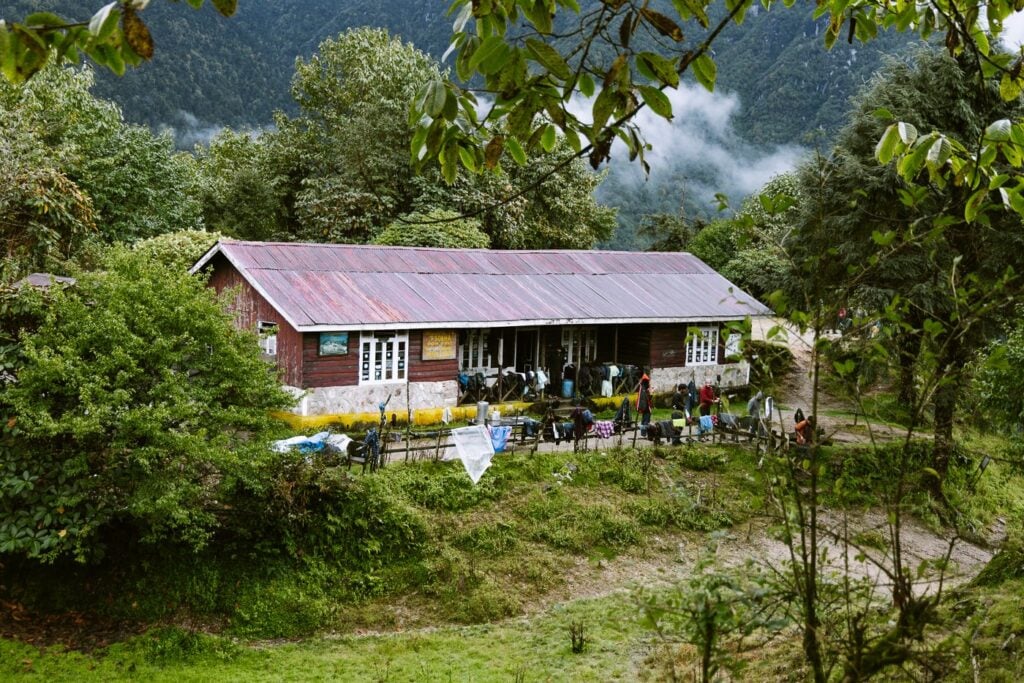







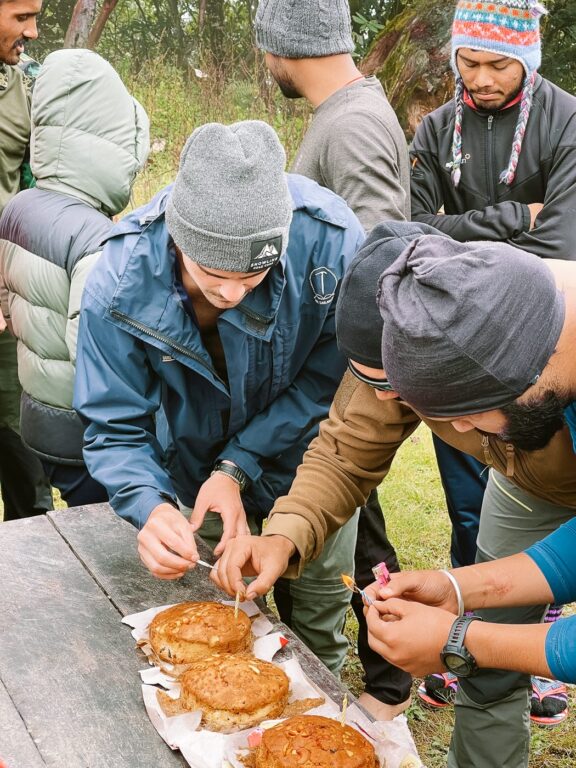
Day 14: Tshoka to Dzongri
Following a successful rest day in Tshoka, it was time to continue the trek to Dzongri, a small settlement at an altitude of 3940 meters. At a time schedule of 5, 6, and 7 (5 am for tea, 6 am for breakfast, and 7 am for departure) we headed off on the steep climb.

The ascent began immediately and continued through the beautiful silver pine and rhododendron forest. If it wasn’t for the fair weather, this trek would have surpassed the previous haul in terms of difficulty. We gained a total of 1058 meters in elevation gain over just 7.1 kilometers.



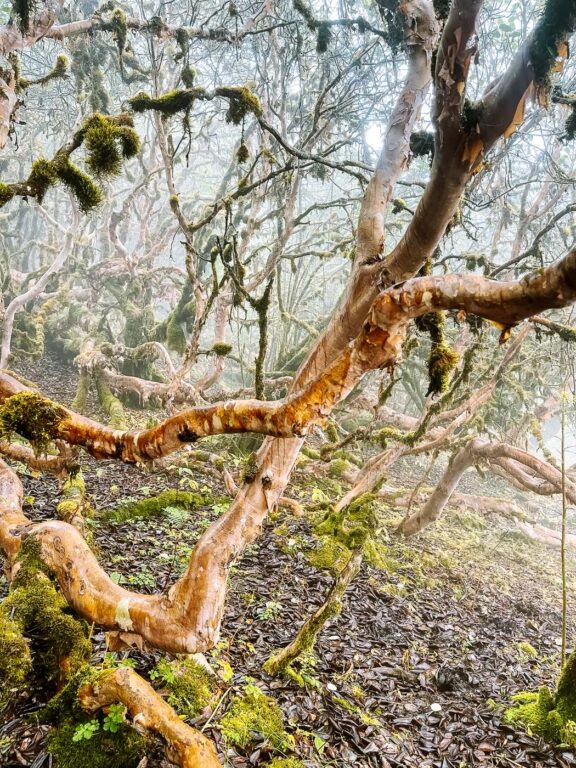

The highest point was at the 5.5-kilometer mark, a 4030-meter ridge marked by cairns and colorful prayer flags. We sat here for a moment to rest following the stew climb, before descending another 100 meters or so to Dzongri.



Dzongri is a beautiful little village sitting beside a gentle stream and comprising a few huts and a small merchant stall offering snacks and other rarities in these wild regions.
We purchased some chocolates, scoffed down our well-earned dal lunch, and then following not more than 15 minutes of rest, we departed for an acclimatization hike to a high viewpoint above Dzongri at 4155 meters (Dzongri Top).



This was a gentle walk without any load and led us to what we were told was a magnificent view of Kanchenjunga and surrounding peaks. Unfortunately, the clouds weren’t offering us any views, but it was still a nice way to wrap up a long day of hiking.
The accommodation at Dzongri was large A-frame tents shared by 6-7 HMI trainees.

Goechala Trek: The first few days of the trip to the Indian Himalayan Mountaineering Institutes’ base camp follows the trekking route called the Goachala Trek. While nowhere near as popular as trails in Ladakh or Uttarakhand, this trek is arguably just as beautiful, finishing with amazing views of Mount Kanchenjunga.
Day 15: Dzongri to HMI Base Camp
Finally, it was time to embark on the final ascent to the HMI Base Camp (4500 m). Just as the day before, we packed up our gear and began trekking at 7 am.
The trek was approximately 10.5 kilometers and involved a steady, gentle incline towards Dzongri La, a pass situated just 100 meters lower than the Himalayan Mountaineering Institutes’ famous base camp. From this pass, we descended gently into the Rathong glacial valley below to approximately 4000 meters, crossed the Rathong River, and began the gentle climb back up the ridge to base camp.






At this stage, we were kicking ourselves for the luck we brought. Yet again the day was foggy and not a single peak managed to penetrate the thick clouds. Apparently, Kangchenjunga (8586 m), the world’s third tallest mountain, is normally visible from the Dzongri La section on a clear day.


However, we were still able to make it to base camp by 1:30 pm, which was acceptable considering the many mandatory breaks we were forced to endure.
The rest of the afternoon was spent getting accustomed to our new home for the week ahead. We sat outside waiting for the clouds to clear to witness the famous Himalayan view but again, had no luck on this front.
Our assigned accommodation was in “Tisco Hut”, a wide dorm-style hut with a single bunk bed row spanning roughly 15 meters across. In this hut, just over 50 men were able to secure a spot for their mattress, which would be our “bed” for the next week.


Day 16: First Day at HMI Base Camp
After a surprisingly sound sleep, we were woken up at 4 am by enthusiastic coursemates who apparently have no concept of silence while others sleep.
I’m talking loud chatting, dramatic yawning, and even music playing while four dozen other people were trying to sleep… Besides the rude awakening, the first day at HMI Base Camp was quite enjoyable.
We began the day with a short hike to a viewpoint above the base camp, where we had a lecture on surrounding peaks. Unfortunately, the clouds were still too stubborn to part, and we were left questioning whether or not these peaks existed or not.




After returning to base camp, our instructors assigned us “central equipment”, including ropes, carabiners, and pitons, as well as 6000-meter snow boots, an ice axe, and crampons.
The rest of the afternoon was spent getting accustomed to the gear, with a theory lecture on glacier climbing and using our new boots.

The same hindering landslides that challenged us on the journey from Yuksom to Thoka also meant that mules and yaks were unable to make the same journey. The result was limited food rations for the trek from Yuksom and at base camp. Needless to say, we were all very sick of dal and rice, which was the only thing we ate for breakfast, lunch, and dinner daily.
Day 17: First Glacier Training Day
After over two weeks, it was finally time to train on the Rathong Glacier. Today also marked the first day of the official end of the Monsoon, and it did so in fashion, with the clouds clearing during our morning chai to finally reveal the beautiful surrounding Sikkim peaks.
Visible were the icy peaks of the Kabru mountain group including Rathong (6678 m) and Kokthang (6148 m), as well as Mount Frey (6010 m) and BC Roy (5480 m).








After breakfast, we hiked for 2.5 hours along the sandy moraine to reach the Rathong Glacier, where we donned our harnesses and strapped on our crampons.



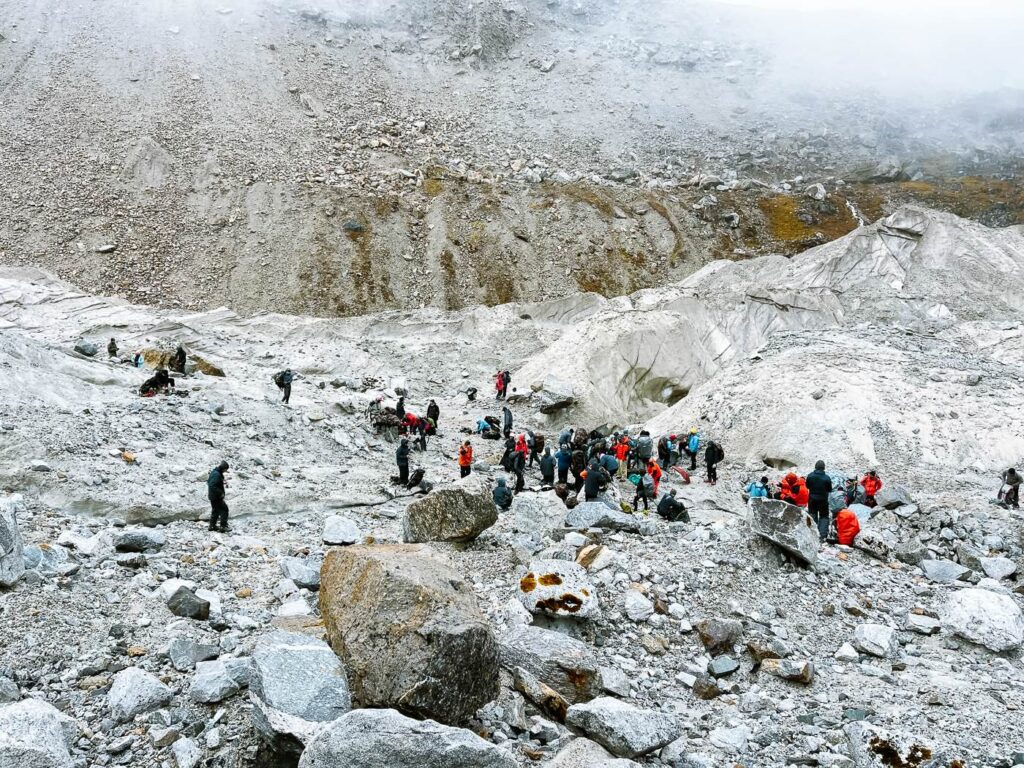
Next, we teamed up in our ropes and practiced several glacial traverse techniques including ascending and descending with various methods of ice axe and crampon techniques.

In total we spent roughly 3 hours at the glacier before turning back, arriving at HMI Basecamp at 2:30 pm.
After lunch, we all crammed into the tiny mess hut and were given a thorough lecture on glaciers.

Day 18: Ice Climbing on Rathong Glacier
Just like the morning prior, the clouds conformed to their seasonal October shift that marked the end of Sikkim’s seasonal monsoon and awarded us with a spectacularly clear mountain morning.

After breakfast, we once again set off for the glacier training area, this time with more confidence in the use of technical ice climbing equipment.
The 2-hour walk out to the glacier is one I certainly didn’t mind repeating. The winding labyrinth through the Rathong moraine is spectacularly beautiful, with the Kabru peaks and the three Forked Peaks staring down on us from their high perch.
Below are some mountain shots I captured on the way.


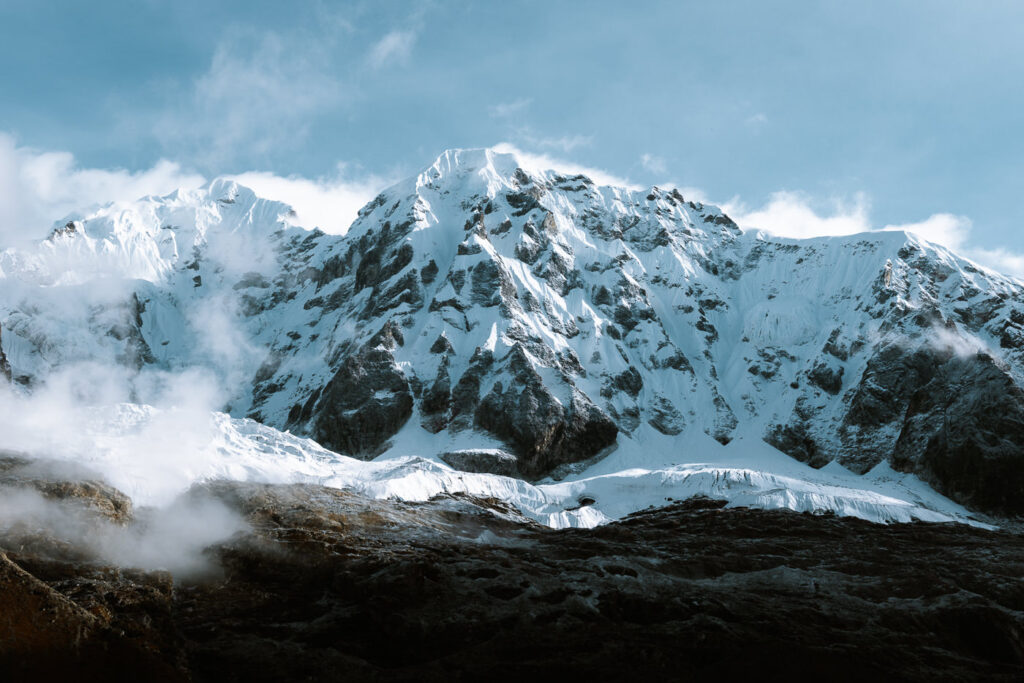




Today’s lesson involved double ice axe climbing, this time up a 20-meter ice wall while belayed on a top rope. The purpose of this glacier training was to get more experience and confidence using our crampon front points to balance on a vertical ice face.





After a few hours of training, we returned to HMI Basecamp content with a solid day of Himalayan mountaineering training. After lunch, our instructors told us that we had the remainder of the day off, and we hung out around the camp and enjoyed being in one of the most beautiful regions on earth.

Day 19: Aid Climbing and River Crossing Practice
Today marked the fifth day of living at 4500 meters, and our bodies were finally getting more adjusted to the altitude. After another magnificent, cloudless morning, we fell in and separated in ropes at three different stations around camp.
Throughout the day, we rotated between these stations, which involved training specific river crossing techniques including travel traverse and suspension traverse, as well as climbing rock faces with the use of double Jumar (chest and foot jumar), and a very informative map reading activity. In all honesty, this was my personal favorite day of the HMI basic mountaineering course so far, with fabulous weather and fun, informative training activities.
In the afternoon, all trainees reported for a late afternoon demonstration on rope fixing and ascending on a fixed rope, which would prepare us for the next day’s glacier training session.










Day 20: Bad Weather in Sikkim
Unfortunately, our clear weather luck had run out on day 20.
Rain poured from midnight and well into the day. The result was a postponed day of glacier training. Instead, we practiced one of the most essential skills in mountaineering- patience. We hung out at HMI Base Camp, played cards, and prayed for good weather in the coming days.
Luckily the clouds began to clear in the late afternoon, which meant our instructors could host a demonstration on ice axe self-arrest techniques on the grassy slopes near advanced mountaineering course tents.

Day 21: Jumar Ascent on Rathong Glacier
The poor weather persisted through the night and into the early morning. Nerves were high as our instructors postponed the daily fall-in by an hour to keep an eye on weather conditions. However, in the end, we decided to push on to the glacier in the rain as otherwise, we would have missed out on one of the most essential mountaineering skills for future expeditions- ascending on a fixed line using a jumar and crampons.
The weather worsened as we approached the glacier, but we pushed through and were able to get a few solid hours of jumar training under our belt. As we returned to base camp, the sun poked through the fog, signifying the start of a lovely rest of the afternoon in which we were offered a lecture on crevasse rescue.






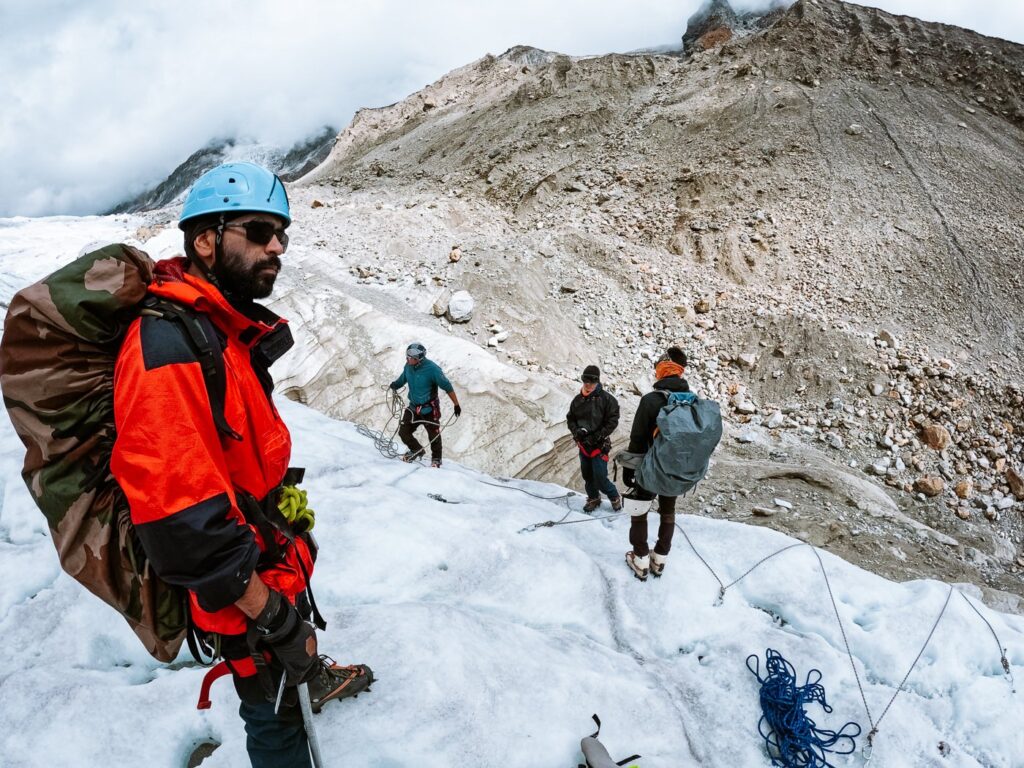
Day 22: Final Glacier Training Day
After a week at HMI base camp, the final glacier training day was finally upon us.
Following an early start, we made the final trek over the golden hills, through the boulders and dark earth of the moraine, and onto the glacier. Today, our instructors set up several training stations, including a crevasse rescue exercise using C-pulley and Z-pulley systems, an ice piton fixing station, and two glacier climbing exercises using jumars and ice axes.











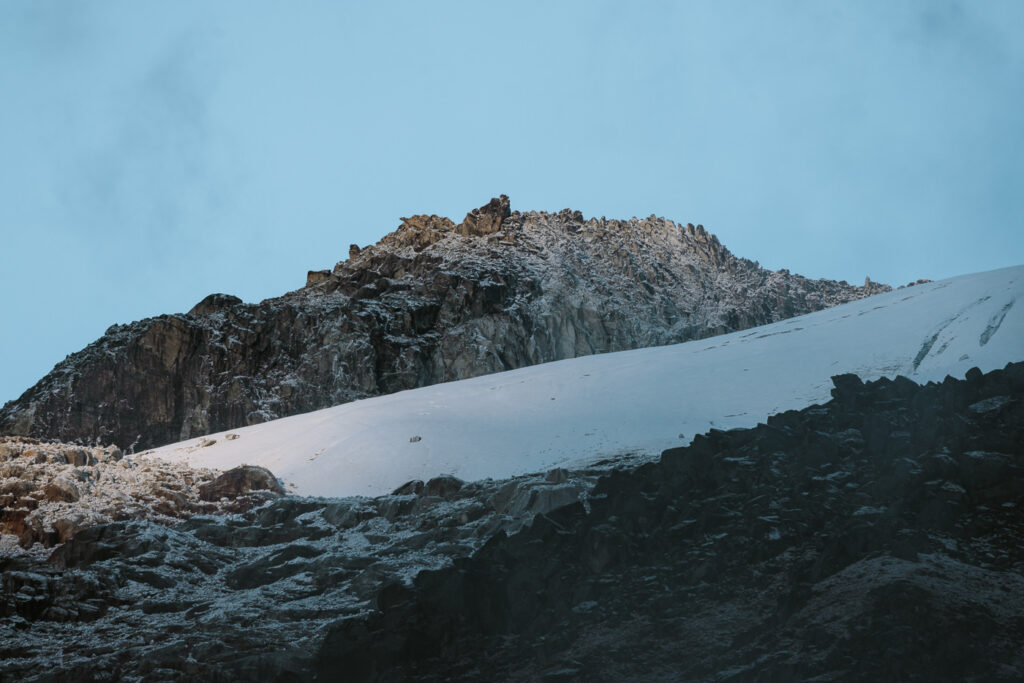



At the conclusion of the drills, we all took some celebratory photos together on Rathong Glacier, before turning back and trekking back to base camp through the rain. Once we arrived, we fell in and were prepped for the following day, where we were to climb a nearby rocky peak called Renok (Black Peak).

Day 23: Height Gain on Renok Peak
The mountains gifted us with a beautiful clear morning on our final full day at HMI base camp, where we were set to climb a nearby rocky peak called “Black Peak” or “Renok Peak”.
The trek began on the opposite end of the camp from the now very familiar route to the glacier. The trail bent around some sweeping hills and undulated lightly through a beautiful clear valley, with the Fork Peaks, Kapru Dome, and Kapru South in full view for the majority of the morning.















After about an hour and a half, we began a short-lived but steep ascent before arriving at a boulder field. Here, we strapped into our harnesses and roped up in groups of 5 to make the light scramble to the summit. Disappointingly for me, this was quite an easy climb that required very little technical effort. However, it was clear that this was the first time several people on our course were exposed to scrambling on semi-exposed rock.

As a result, the climb took much longer than it should have. At the summit, we were told the altitude of this peak pushed beyond 5000 meters. Conversely, a quick map search confirmed my Garmin’s altimeter’s reading of just below 4,800 meters. Disappointingly, we were told that if we wanted to climb Frey Peak or anything above 5500 meters, we would have to return for the advanced mountaineering course at HMI.



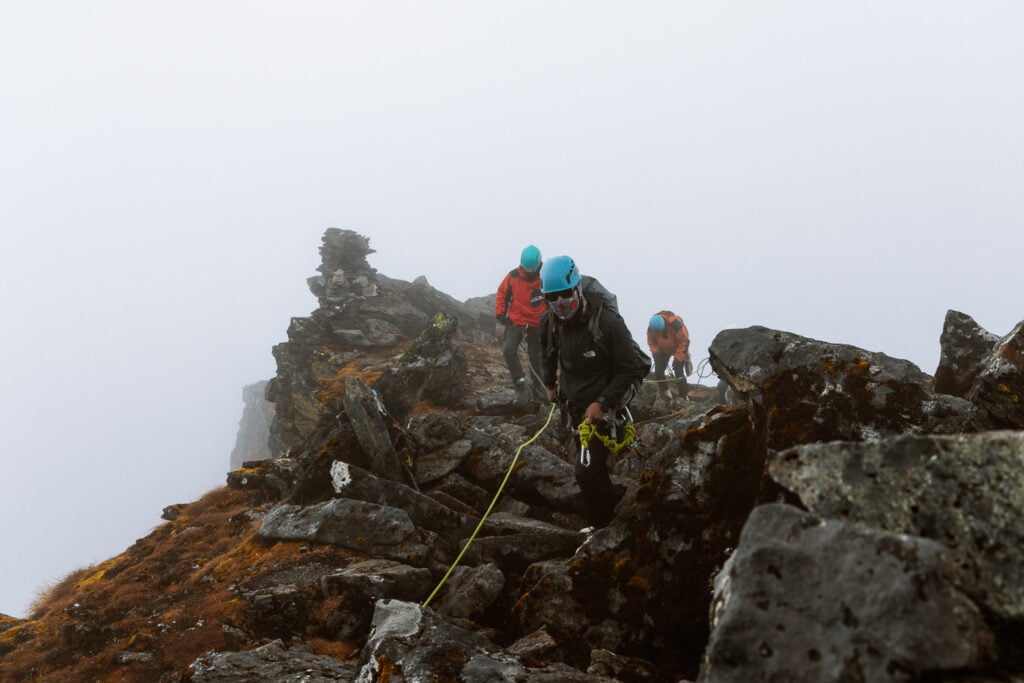
This was contradictory to what I’d been told by HMI staff when I signed up. I don’t want to sound like I’m complaining but this is good to know for those of you interested in getting a climb in for “height gain” day.
That afternoon, we fell in for the last afternoon session and returned our central equipment and glacier training gear including snow boots, crampons, and ice axes. Our instructors also briefed us on the coming trek back to Yuksom which would begin early the following day.





Day 24: The Sikkim Descent: HMI Base Camp to Tshoka
We awoke on the morning of day 24 at 4:30 am to pack our bags and fall in for the final time at HMI Base camp.
Today, we had a long trek ahead, this time again with heavy loads but the distance would be doubled from the route up as our goal was Tshoka, 1,500 meters lower.
We internalized our goodbyes to the silver peaks and corrugated iron huts that had been our home for the past week and began the rolling descent down the Rathong Valley towards Dzongri La (Dzongri Pass)





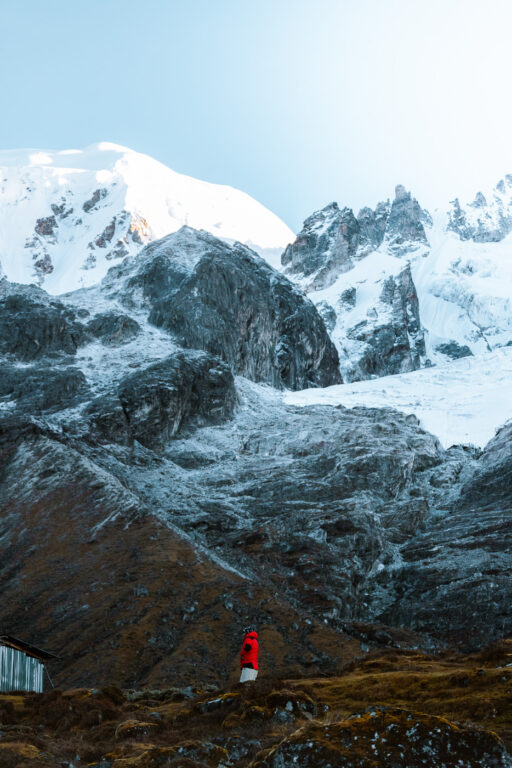


It took us one day to cover the distance we did in two the week prior and arrived at Tshoka at around 3:30 pm.



Day 25: Tshoka to Himalayan Mountaineering Institute
The final descent from Tshoka back to Yuksom involved a knee-burning 1,500-meter total elevation drop over the wet and muddy 15-kilometer path through the Sikkim foothills. We set a decent pace from the onset but unfortunately, our instructors committed to overly-frequent rest stops to wait for the group to catch up as one, which put a hamper on the overall enjoyment of the trek for me.
I’m never in the rush to finish a trek, but constantly stopping every 10 minutes for a break really breaks up the flow of the hike and is one thing I struggled with.
Nevertheless, this region, while wet, muddy, and leech-filled is undeniably beautiful. Dense rainforest covers the majority of the path, frequently crossing pure streams sourced from megalithic waterfalls draping the ever-rising slopes.
We arrived at Yuksom at roughly 3:00 pm, polished off a quick meal of rice and dal, and set off for HMI in our jeep convoy.
Again, as foreigners we stopped at the border checkpoint out of Sikkim to stamp our passports, arriving at the Himalayan Mountaineering Institute Campus by 6:30 pm.

Day 26: HMI Sports Climbing Competition
To most accustomed to the comforts of regular life, the bunk beds at HMI are far from what we’d call luxury. But, after spending close to a fortnight sleeping on a few planks of wood lined by a 5 mm thin yoga mat in a narrow, tunneled hut shared by over 50 men at altitude– the first night back at HMI felt irrationally lavish.
Waking up from a long, uninterrupted sleep, we ate breakfast and fell in at the courtyard. Our instructors prepared us for the coming two final days, which would involve a sports climbing competition, returning our equipment, and the final graduation.
The first thing in store for us was the sports climbing competition. We were hoping that this would be held on the big outdoor wall, but it ended up being a simple, timed route on the indoor wall. We’d only get one chance to reach the top, following the marked route, and the fastest person to complete it would win. To my surprise, only four people managed to complete the route from the entire batch.
Then, once everyone had climbed, we gathered our equipment, including all the trekking gear, harness sets, and rented clothing, and returned it to the Equipment Room in a rope-wise manner.

Day 27: Graduation
The final day at HMI involved little learning or physical training but was a good practice in patience for the long, arduous bureaucratic formalities expected of an Indian government institute.
It took 2.5 hours for us to line up and wait for each student to receive a pin, followed by a quick handshake from the president. In the end, I was certainly glad the “graduation ceremony” was over.
Regardless, as soon as it was, we all enjoyed taking group photos, congratulating each other, and sharing an overall sense of accomplishment.
Usually, candidates would stay an additional night after graduation and depart the following morning after breakfast. However, a couple of us had arranged for an early departure following the graduation, which meant we quickly had to run around the campus for a final cut of the red tape to attain clearance signatures from all offices to leave.
Departing HMI left me with mixed emotions. I would be lying if I said I wasn’t happy to be finished, but the memories and experience I’d earned at HMI will stick with me for life.


Fun Things to do in Darjeeling After the Basic Mountaineering Course
Preparing For the BMC at the Darjeeling Himalayan Mountaineering Institute
Decided that you’re going to take the plunge and commit to the 28-day Basic Mountaineering Course at HMI Darjeeling? Here are a few tips for preparation.
Recommended Gear
As mentioned in the above equipment section, HMI Darjeeling provides the majority of the equipment that you’ll need.
However, if you’re serious about mountaineering, it’s a good idea to invest in some technical equipment of your own. If you’re going to do so, then buying this for the course is a good idea, since you’ll get to practice with the gear that you’ll actually use to summit peaks in the future.
Recommended gear for mountaineers that you might want on the course include:
- Good weatherproof jacket – GoreTex or similar membranes are ideal but expensive. Don’t be one of those guys bringing an umbrella to a mountaineering expedition!
- Warm base layers – essential at high altitudes
- Deodorant – please guys!
Water bottle filter – unfortunately, this Gora got stomach problems due to the water after drinking unfiltered. After this I filtered all my water using myGrayl GeoPress water bottle – highly recommend water bottle filters to any serious adventurer instead of straw filters.Climbing harness – lightweight harnesses are better for high-altitude expeditionsIce Axe – the ones that HMI provides are a little outdated, blunt and straight, non-technical variationsCrampons – similarly, having your own crampons means you can keep them sharp, making glacial traverses and front-pointing much easier and safer- 6000 m+ snow boots – a second pair of boots that are essential for glacier training and high-altitude expeditions. The boots provided by HMI are cheaper, hard-plastic boots. Good brands for comfort, safety, and longevity are La Sportiva, Millet, Scarpa, and similar
GoPro – the most versatile camera to capture memories. I recommend a 3M mount as well to record climbing (fixed to your helmet)- Hiking Backpack – I used the HMI backpack, however, I recommend bringing your own as I was not a fan of the mount. A 60-70L pack is recommended for the course.
- Multiple pairs of socks – I recommend bringing 3-4 pairs of trekking socks at least.
- Sleeping bag – the one provided is adequate but has been used by hundreds of people before you. If you’re hygiene-conscious, it’s a good idea to bring your own. A -20ºC bag is a good option.
- Sleeping mat – the yoga mat-style sleeping mate provided does the job but is not very comfortable. The
Therm-a-Rest Z-Lite is a great option if you’re planning on future expeditions.
Fitness
While I can confirm that the course is not overly physically demanding for those of us who have spent a fair bit of time trekking or embarking on other adventure activities, it was clear that many candidates did not take preparation seriously. Hence, several failed the Pandem Test and were not permitted to continue on the trek to HMI Base Camp.
On the other hand, it was clear after day one of PT that I overprepared physically. Overall, the PT was much too easy and didn’t provide much benefit for me, nor did the tests provide the challenge that I was looking for.
HMI provides a recommended pre-course training program. However, I don’t think this is a very good one for the activities you’ll be performing.
As a baseline, I recommend that every candidate prepares by working up to sustaining a 5-6 kilometer run with an incline. I also recommend doing physical exercises like pushups, situps, and squats, which will help with PT and overall strength for climbing.
Additionally, if you have access to a climbing wall in your town or city, getting some basic rock climbing experience will also come in handy.
Alternative Mountaineering Institutes in India
While HMI is arguably the most famous mountaineering school in India, there are several others to consider as well.
The most reputable schools include:
- Nehru Institute (NIM) – Uttarkashi
- Atal Bihari Vajpayee Institute of Mountaineering and Allied Sports (ABVIMAS) – Manali
- Jawahar – Pahalgam
I have heard great things about both Nehru Institute and ABVIMAS and spoken to instructors from both schools who highly recommend their courses.
There are several other institutes including one in nearby Gangtok., However, these are reserved for military training only.

Final Review: Would I recommend HMI to Aspiring Mountaineers?
If you’ve read my comprehensive day-by-day breakdown, then you know that I have both great and not-so-great things to say about HMI Darjeeling.
Pros
Overall, I would certainly recommend anybody who is serious about acquiring as many mountaineering skills as possible for the most cost-effective price. Climbing schools in the Alps and North America ask for upwards of $8,000 for condensed versions of these courses (10-14 days). Comparably, HMI’s course costs an eighth of this.
On the other hand, if you instead choose to embark on some organized 6000-meter expeditions to begin learning mountaineering skills, I’d say that you’d have to complete at least 3 or 4 to get the same level of practical experience as the BMC. Again, this would cost several thousand dollars anywhere in the Himalayas, including Nepal.
In terms of value for money, the BMC at HMI is a no-brainer.
Furthermore, training on the Rathong Glacier is amazing. West Sikkim is one of the most picturesque and remote regions of the Himalayas, and you will be training on blue ice beneath some of the world’s most majestic peaks. In fact, this region is blocked off to the public, and only military and HMI candidates are permitted here!
For foreigners, spending time in India is also a valuable experience. Although you’ll undoubtedly get hit with some culture shock, Indian people are among some of the friendliest on earth and you’ll make some lifelong friends in this course. Even though I had traveled in India extensively prior to this, I was still surprised by just how welcoming and kind Indians are to foreigners.
Lastly, several of the instructors are incredibly experienced, with huge mountaineering feats like the seven summits under their belts. This offers a good opportunity to learn from highly skilled and respected mountaineers.
Cons
Training at HMI, or any mountaineering institute in India, has in my opinion, some pitfalls.
Firstly, the course structure and content are quite regimented. While both Nepal and western climbing nations shifted to a more effective and flexible, small-team approach decades ago, India still sticks to its militaristic view of mountaineering.
For example, the majority of alpine ascents in India are still completed by military regiments rather than small groups of dedicated mountaineers. Being a government institute, HMI embraces this approach in its training and its teaching of alpine climbing. Of course, as a foreigner leaving HMI, I’m far more likely to climb on smaller expeditions of 4-8 people, rather than upwards of 30 in a hierarchical, military fashion– so, much of the structural and cultural elements that HMI teach is wasted on me.
Of course, this has mixed perceptions, but in my view, this is an outdated and ineffective approach to mountaineering.
Consequently, while at the institute, you are treated like an army cadet, not an aspiring climber. Expect strict rules and limits on your freedom of movement (even after training hours), as well as having to line up and wait for hours to listen to bureaucratic nonsense. The most frustrating part for me as a western climber is being forced to pay respects to titles, even to those individuals who have never stepped foot on a summit- I look forward to the day that India starts to acknowledge that respect is earned by character and merit, not given in titles.
Don’t get me wrong, I would embrace a regimented schedule if the course coordinators were able to stick to it themselves. Unfortunately, you’ll be standing around a lot in this course as organization and coordination is severely lacking. As a single, simple example (trust me, there are many), instead of breaking up the course into segments for each activity, 60+ candidates get asked to stand in a line and wait for their turn to climb an artificial wall once, all while a dozen instructors watch on. There are loads of examples like this that you’ll endure throughout the course– but I think you get my point.
Unfortunately, as an Indian candidate told us. This is an Indian Government institute. While they’ve had over six decades to solve their issues, things apparently don’t change with these types of structures.
Conclusion
I apologize for the above rant. However, my goal as always is to provide you with the most honest account in my reviews. In order to do that, I have to let you in on both the good and the bad.
With that said, even with all of the pitfalls and frustrating moments at HMI, I would certainly recommend the experience to anybody serious about beginning their mountaineering journey.
Looking back now, this was one of the most memorable adventure travel experiences I’ve had to date.
Some of the people that I had the privilege of meeting will be friends for life. And, the experience that I gained in Sikkim, along with the knowledge passed down to me at the HMI campus has already proved to be extremely useful in the mountains.
However, aspiring mountaineers who value their time more than their money would do better training at a European or North American mountaineering school, where the structure and systems are more fine-tuned to modern alpine climbing.

More Photos from the BMC With HMI Darjeeling













More Adventure Inspiration After The Mountaineering Course
I hope that you’ve enjoyed this comprehensive blog post about training at the HMI Darjeeling mountaineering institute in India. While you’re still here on my blog, check out some of my other guides to India below for more adventure travel inspiration.




